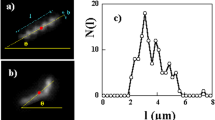Abstract
Spiroplasma swim in liquids without the use of the bacterial flagella. This small helical bacterium propels itself by generating kinks that travel down the cell body. The kink translation is unidirectional, from the leading pole to the lagging pole, during cell swimming in viscous environments. This protocol describes a swimming motility assay of Spiroplasma eriocheiris for visualizing kink translations of the absolute handedness of the body helix with optical microscopy.
Access this chapter
Tax calculation will be finalised at checkout
Purchases are for personal use only
Similar content being viewed by others
References
Shaevitz JW, Lee JY, Fletcher DA (2005) Spiroplasma swim by a processive change in body helicity. Cell 122:941–945. https://doi.org/10.1016/j.cell.2005.07.004
Miyata M, Robinson RC, Uyeda TQP et al (2020) Tree of motility – a proposed history of motility systems in the tree of life. Genes Cells 25:6–21. https://doi.org/10.1111/gtc.12737
Sasajima Y, Miyata M (2021) Prospects for the mechanism of Spiroplasma swimming. Front Microbiol 12:706426. https://doi.org/10.3389/fmicb.2021.706426
Nakane D, Ito T, Nishizaka T (2020) Coexistence of two chiral helices produces kink translation in Spiroplasma swimming. J Bacteriol 202:e00735–e00719. https://doi.org/10.1128/JB.00735-19
Goldstein RE, Goriely A, Huber G et al (2000) Bistable helices. Phys Rev Lett 84:1631–1634. https://doi.org/10.1103/PhysRevLett.84.1631
Wolgemuth CW, Charon NW (2005) The kinky propulsion of Spiroplasma. Cell 122:827–828. https://doi.org/10.1016/j.cell.2005.09.003
Wada H, Netz RR (2007) Model for self-propulsive helical filaments: kink-pair propagation. Phys Rev Lett 99:108102. https://doi.org/10.1103/PhysRevLett.99.108102
Wada H, Netz RR (2009) Hydrodynamics of helical-shaped bacterial motility. Phys Rev E 80:021921. https://doi.org/10.1103/PhysRevE.80.021921
Yang J, Wolgemuth CW, Huber G (2009) Kinematics of the swimming of Spiroplasma. Phys Rev Lett 102:218102. https://doi.org/10.1103/PhysRevLett.102.218102
Trachtenberg S, Gilad R (2001) A bacterial linear motor: cellular and molecular organization of the contractile cytoskeleton of the helical bacterium Spiroplasma melliferum BC3. Mol Microbiol 41:827–848. https://doi.org/10.1046/j.1365-2958.2001.02527.x
Kurner J, Frangakis AS, Baumeister W (2005) Cryo-electron tomography reveals the cytoskeletal structure of Spiroplasma melliferum. Science 307:436–438. https://doi.org/10.1126/science.1104031
Sasajima Y, Kato T, Miyata T et al (2022) Isolation and structure of fibril protein, a major component of the internal ribbon for Spiroplasma swimming. Front Microbiol 13:1004601. https://doi.org/10.3389/fmicb.2022.1004601
Ku C, Lo W-S, Kuo C-H (2014) Molecular evolution of the actin-like MreB protein gene family in wall-less bacteria. Biochem Biophys Res Commun 446:927–932. https://doi.org/10.1016/j.bbrc.2014.03.039
Takahashi D, Fujiwara I, Miyata M (2020) Phylogenetic origin and sequence features of MreB from the wall-less swimming bacteria Spiroplasma. Biochem Biophys Res Commun 533:638–644. https://doi.org/10.1016/j.bbrc.2020.09.060
Takahashi D, Fujiwara I, Sasajima Y, et al (2022) Open Biol 12:220083. https://doi.org/10.1098/rsob.220083
Harne S, Duret S, Pande V et al (2020) MreB5 is a determinant of rod-to-helical transition in the cell-wall-less bacterium Spiroplasma. Curr Biol 30:4753–4762.e4757. https://doi.org/10.1016/j.cub.2020.08.093
Masson F, Pierrat X, Lemaitre B et al (2021) The wall-less bacterium Spiroplasma poulsonii builds a polymeric cytoskeleton composed of interacting MreB isoforms. iScience 24:103458. https://doi.org/10.1016/j.isci.2021.103458
Kiyama H, Kakizawa S, Sasajima Y et al (2022) Reconstitution of a minimal motility system based on Spiroplasma swimming by two bacterial actins in a synthetic minimal bacterium. Sci Adv 8:eabo7490. https://doi.org/10.1126/sciadv.abo7490
Lartigue C, Lambert B, Rideau F et al (2022) Cytoskeletal components can turn wall-less spherical bacteria into kinking helices. Nat Commun 13:6930. https://doi.org/10.1038/s41467-022-34478-0
Liu P, Zheng H, Meng Q et al (2017) Chemotaxis without conventional two-component system, based on cell polarity and aerobic conditions in helicity-switching swimming of Spiroplasma eriocheiris. Front Microbiol 8:58. https://doi.org/10.3389/fmicb.2017.00058
Wang W, Gu W, Gasparich GE et al (2011) Spiroplasma eriocheiris sp. nov., associated with mortality in the Chinese mitten crab, Eriocheir sinensis. Int J Syst Evol Microbiol 61:703–708. https://doi.org/10.1099/ijs.0.020529-0
Manson MD, Tedesco P, Berg HC et al (1977) A protonmotive force drives bacterial flagella. Proc Natl Acad Sci U S A 74:3060–3064. https://doi.org/10.1073/pnas.74.7.3060
Shimada K, Kamiya R, Asakura S (1975) Left-handed to right-handed helix conversion in Salmonella flagella. Nature 254:332–334. https://doi.org/10.1038/254332a0
Boudet JF, Mathelié-Guinlet M, Vilquin A et al (2018) Large variability in the motility of spiroplasmas in media of different viscosities. Sci Rep 8:17138. https://doi.org/10.1038/s41598-018-35326-2
Koch M, Rohrbach A (2012) Object-adapted optical trapping and shape-tracking of energy-switching helical bacteria. Nat Photon 6:680. https://doi.org/10.1038/nphoton.2012.232
Jori G, Fabris C, Soncin M et al (2006) Photodynamic therapy in the treatment of microbial infections: basic principles and perspective applications. Lasers Surg Med 38:468–481. https://doi.org/10.1002/lsm.20361
Dwyer DJ, Belenky PA, Yang JH et al (2014) Antibiotics induce redox-related physiological alterations as part of their lethality. Proc Natl Acad Sci U S A 111:E2100–E2109. https://doi.org/10.1073/pnas.1401876111
Roth J, Koch MD, Rohrbach A (2018) Dynamics of a protein chain motor driving helical bacteria under stress. Biophys J 114:1955–1969. https://doi.org/10.1016/j.bpj.2018.02.043
Acknowledgments
This study was supported in part by KAKENHI (16H06230, 20H05543, 21 K07020, 22H05066) to DN.
Author information
Authors and Affiliations
Corresponding author
Editor information
Editors and Affiliations
Rights and permissions
Copyright information
© 2023 The Author(s), under exclusive license to Springer Science+Business Media, LLC, part of Springer Nature
About this protocol
Cite this protocol
Nakane, D. (2023). Swimming Motility Assays of Spiroplasma. In: Minamino, T., Miyata, M., Namba, K. (eds) Bacterial and Archaeal Motility. Methods in Molecular Biology, vol 2646. Humana, New York, NY. https://doi.org/10.1007/978-1-0716-3060-0_31
Download citation
DOI: https://doi.org/10.1007/978-1-0716-3060-0_31
Published:
Publisher Name: Humana, New York, NY
Print ISBN: 978-1-0716-3059-4
Online ISBN: 978-1-0716-3060-0
eBook Packages: Springer Protocols




